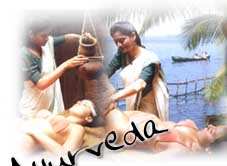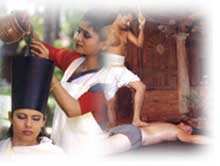Kerala and the people of kerala are famous for their extensive use of
ayurvedic concepts for keeping a sound body and mind. Kerala homes
numerous rare species of herbs and plants, which are of great medicinal
value in ayurveda. there are many prominent institutions in kerala who
offer ayurvedic treatment for most kinds of illness. Ayurvedic treatment
in kerala is a star attraction for the tourists,bcos ayurveda is a
treatment without side effects !!!.
The Art & Science of Living
Ayurveda, translated as the art and science
of living is a systematic approach which utilizes all that nature
provides (foods, spices, herbal medicines, colours, metals, gems, sound)
to not only overcome illness but continually strengthen oneself.
Ayurveda evolved in an ancient culture which understood the human
condition to be limitless; the day to day implementation of Ayurvedic
principles creates a strong body, clarity of mind and tranquillity of
spirit so the individual may move closer to realizing her/his true
potential. In order to further this movement the disciplines of Yoga and
Tantra are allied to Ayurveda.
Ayurveda means 'Knowledge of Life'. This system of medicine is derived from philosophical theories propounded in India over 2,000 years ago. More than being a system of treatment this system's thrust is the prevention of disease, through a harmony in body composition.
The basic concept of ayurveda is that the body is composed of three principles: pittha, kapha and vatha. These are called the tridoshas. Each dosha is located in a certain organ of the body and is a combination of the five natural resources (earth, fire, water, air and space or ether). Depending on the predominance of a particular dosha, an individual falls into a particular character type and is prone to particular types of diseases. For example people of the pittha type are said to be hot tempered and competitive. They are thought to be more prone to ulcers and rashes.
Depending on the analysis of the patient type, ayurveda advises a particular diet, treatment and care. There are different types of treatments in ayurveda.
Genesis and Development
Ayurveda, the oldest system of medicine in the
world, traces its roots to the Vedic period in ancient India (1500
B.C.). The Rig Veda, a compilation of verse on the nature of existence,
is the oldest surviving book of any Indo-European language (1500 B.C.).
The Rig Veda refers to the cosmology known as Sankhya which lies at the
base of both Ayurveda and Yoga; in it are verses on the nature of health
and disease, pathogenesis and principles of treatment. The Atreya
Samhita is the oldest medical book in the world; it survives from
Takashila University which was operating as early as 800 B.C.
The Atharva Veda (800 B.C.) lists the Eight Divisions of Ayurveda: Internal
Medicine, Surgery of Head and Neck, Opthamology and Otorinolaryngology,
Surgery, Toxicology, Psychiatry, Paediatrics, Gerontology or Science of
Rejuvenation, and the Science of Fertility. At 500 B.C. at the
university at Benares, Sushruta, a surgeon who developed the operative
techniques of rhinoplasty (plastic surgery), wrote the Sushruta Samhita
which describes a highly developed surgery. In l00 A.D., the physician
Charaka revised and supplemented the Atreya Samhita; the Charaka Samhita
is a major work on internal medicine.
Influence of Ayurveda on East and West
By 400 A.D., Ayurvedic works
were translated into Chinese; by 700 A.D., Chinese scholars were
studying medicine in India at Nalanda University. Indian thought, as
well as influencing Chinese spirituality and philosophy through
Buddhism, greatly influenced Chinese medicine and herbology through
Ayurveda. In 800 A.D., Ayurvedic works were translated into Arabic. A
century later, under physicians such as Avicenna and Razi Serapion, both
of whom quoted Indian texts, Islamic medicine became very influential in
Europe, helping to form the foundation of the European tradition in
medicine. In 16th century Europe, Paracelsus, who is known as the father
of modern Western medicine, practised and propagated a system of
medicine which borrowed heavily from Ayurveda.
Ayurveda Today
In the modern world, Ayurveda is increasingly popular
because it speaks to those elementary concepts of (1) contact with
nature, (2) holism, and (3) we are what we eat. Ayurveda forms an
integral part of the daily regimen of hundreds of millions of people
worldwide. Its principles are utilized not only to treat persons who are
ill but also to prepare a balanced meal and to construct a harmonious
environment. Ayurveda brings to life the concepts of preventive health
care and health promotion. The goal of Ayurveda is to help the
individual discover a personal knowledge of living.
At present, most of us no longer know how to maintain our own health and
are either actively or passively participating in the destruction of the
Earth. We have been taught to maintain the structure of a society that
values the acquisition of wealth above all else. This path continues to
separate us from each other and from everything within nature. Many of
us have decided to reject this and are envisioning a worldview that
acknowledges human needs other than wealth. The Vedic view is that the
human condition is limitless: We have a deep desire to realize unity
with nature and divinity within ourselves. Ayurveda is the knowledge of
what nature in her generosity provides. Yoga and Tantra deepen our
knowledge of who and what we are within nature.
Yoga
Yoga, which means union , is an approach which brings together the
disparate elements within a human being; Yoga is not just body postures
but anything which serves to unify the individual into a whole. Within
us all there are different motivations, desires and goals which are
contradictory to each other; every circumstance brings forth courage and
fear, prospects of pleasure and pain, judgments of good and bad. Our
actions do not satisfy all the different needs and desires that exist
within; whatever is left unsatisfied expresses itself through the body/
mind as illness. The path of Yoga calls for an intense awareness of mind
and body so that our actions arise from the totality of who and what we
are. A yogi aspires to incorporate elements generally unavailable to
conscious awareness, into her/his daily life.
Tantra
Tantra is a systematic approach to dissolve personal
limitations. As our limitations have intimately to do with our notions
of good and bad, real and unreal, the Tantric approach is to continually
redefine personal reality. A Tantric is a person for whom the removal of
limitations is more compelling than the maintenance of any given
personal reality, no matter how pleasant or beautiful it may be. Tantra
is the path of freedom: The Tantric aspires to recognize the unity of
the Human with the Divine.
The linking of the Sanskrit words ayur (life) and veda (knowledge) aptly
describes the essence of this ancient Indian system of medicine. The
foundations of Ayurveda lie in the meticulous observation skills of the
ancients. They observed and recorded the relationship between themselves
and their environment and in the millennia that followed a distinct
clinical system was formulated. An Ayurvedic physician utilizes her/his
observation skills to not only diagnose patterns of imbalance but also
to determine the constitution of the individual and hence is able to
deduce inherent strengths, weaknesses and tendencies. An Ayurvedic
physician is trained in the use of diet, cooking, yoga, breath-work,
meditation and a vast pharmacopoeia in order to help the individual
achieve balance. Ayurveda not only treats persons who are ill but brings
to life the concepts of preventive health care and health promotion. The
goal of Ayurveda is to help each person discover a personal knowledge of
living.
Ayurvedic definition of Health
In Ayurvedic medicine, health is defined as soundness of body (shrira),
mind (manas) and Self (atman). Each of these must be nurtured if the
individual is to create health. Ayurveda offers a holistic approach
based upon the understanding that no single agent by itself causes
disease or brings health.
Life-Force
Ayurveda views the person as a composite of 3 forces:
Vata-The force symbolized by AIR
Pitta-The force symbolized by FIRE
Kapha-The force symbolized by WATER
The quality and the relative balance of these forces determines health
and disease. When these forces act harmoniously, the functions of
digestion, absorption and elimination (physically & mentally) create
health. As these 3 forces are responsible for specific areas of
body/mind function, the symptoms of imbalance indicate which of these
forces is deficient or excessive.
Constitution
The concept of constitution (prakriti) is central to Ayurveda.
Individuals are comprised of the 3 forces (Vata, Pitta, Kapha) in unique
combinations so that no 2 persons are alike. The constitutional
determination provides insight into the deeper workings of an
individual. With this it is possible to become aware of the foods,
spices, herbal medicines, emotions, thoughts, climates, colours,
activities and so on that tend to either balance or unbalance a
particular individual and to either improve or aggravate various types
of illness. Furthermore, it is possible to outline the disease
tendencies of the different constitutions so that a preventive lifestyle
may be observed; also, health promotion for individuals of different
constitutions can follow a rational, time tested approach utilizing all
that nature provides.
Treatment
A disease will manifest in different constitutions in different ways. An
individual with a predominantly Vata constitution will experience
symptoms that are different than those for Pitta or Kapha, even though
they all have been diagnosed with the same disease . Constitutional
treatment of the individual is a priority since the constitution is
fundamental to health and illness.



